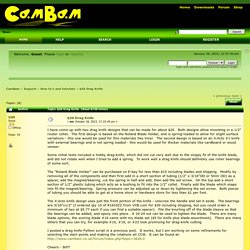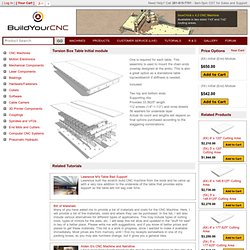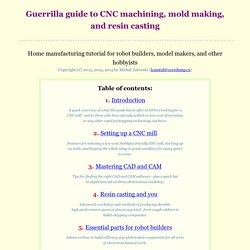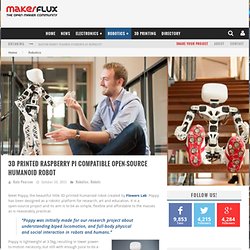

Index -CNC-Plus Germany. $20 Drag Knife. I have come up with two drag knife designs that can be made for about $20.

Both designs allow mounting in a 1/2" router collet. The first design is based on the Roland Blade Holder, and is spring-loaded to allow for slight surface variations - this one would be used for thin materials like Vinyl. Adaptation d'un porte lame Roland pour faire de la découpe vinyl avec une CNC. Les enseignistes connaissent bien la découpe vinyl qui leur permet de faire de nombreux marquages.

Le principe est simple : Une feuille de vinyle autocollante est découpée à l'aide d'un plotter de découpe spécialisé, et l'opération est répétée pour chacune des couleurs nécessaires. Les découpes inutiles sont ensuite 'pelées', et collées à l'envers sur une feuille qui va servir de support pour le transfert sur le support final. Le support final sera ensuite nettoyé et humidifié avec un agent mouillant (eau + produit vaisselle...), qui facilitera le repositionnement de l'autocollant, puis lorsque tout est en place, il suffit de chasser les bulles (et l'eau) avec une raclette. Certes, ces machines sont peu couteuses (à partir de quelque centaines d'euros), mais leur achat n'est envisageable que si l'utilisation est récurrente.
Woodworking for engineers. Calibrating Feeds and Speeds with Carbide Microtools. The first question that most people ask when using carbide mini and micro tools to cut wood (and other soft materials) for the first time, is, "What are the best speeds and feeds?

". What they really want to know is, "How fast I can cut without breaking a bit? What are the optimum cutting conditions with my equipment? " If you are primarliy cutting metal, in most cases, the process of selecting the proper speed (RPM) and feed-rate is relatively straightforward. If you are cutting woods or plastics, the world is not so kind. Nonetheless, it is possible to arrive at an optimum combination of speed and feed reliably and repeatably without experiencing too much brain-death.
The following discussion assumes that: In any particular material, tool performance, and longevity are primarily influenced by: Rabbit Laser USA. Torsion Box Table Initial module. Torsion Box Table Initial module One is required for each table.

This assembly is used to mount the chain ends (overlap designed at the ends). This is also a great option as a standalone table top/workbench if stiffness is needed. Included: Two top and bottom ends Supporting ribs Provides 33.5625" length 112 screws (1/4"-1-1/2") and cross dowels 56 washers for underside layer Actual rib count and lengths will depend on final options purchased according to the staggering combinations.
Related Tutorials Lawrence M's Table Bed Support Lawrence built the scratch build CNC machine from the book and he came up with a very nice addition to the underside of the table that provides extra support so the table will not sag over time. Sorotec. KRESS Milling Motor. Buildlog.net - CNC Laser Buildlogs. Pstoedit.
Guerrilla guide to CNC machining, mold making, and resin casting. Table of contents: 1.

Introduction A quick overview of what this guide has to offer to DIYers looking for a CNC mill - and to those who have already settled on low-cost 3D printing or any other rapid prototyping technology out there. 2. Setting up a CNC mill Pointers for selecting a low-cost, hobbyist-friendly CNC mill, stocking up on tools, and keeping the whole setup in great condition for many years to come. 3. Tips for finding the right CAD and CAM software - plus a quick but in-depth tutorial on three-dimensional modeling. 4. Advanced, workshop-safe methods of producing durable, high-performance parts of almost any kind - from tough rubbers to bullet-stopping composites. 5. Advice on how to build a library of prefabricated components for all sorts of electromechanical work. 6.
A no-nonsense primer on mechanical engineering, gear design, and power transmission layouts. 7. The sort of things you probably need to know to avoid setting yourself on fire. 8. 3D Printed Raspberry Pi Compatible Open-Source Humanoid Robot. Meet Poppy, the beautiful little 3D printed humanoid robot created by Flowers Lab.

Poppy has been designed as a robotic platform for research, art and education. It is a open-source project and its aim is to be as simple, flexible and affordable to the masses as is reasonably practical. “Poppy was initially made for our research project about understanding biped locomotion, and full-body physical and social interaction in robots and humans.” Poppy is lightweight at 3.5kg, resulting in lower power-to-motion necessity, but still with enough juice to do a wide range of tasks. Although the robot is light, this does not automatically point to fragility.
To give Poppy more agility and stability during motion, bio-inspired morphology has been incorporated into the robots design including, bended legs, a multi-articulated trunk and a soft body. Fully assembled Poppy stands at 84cm, and take’s about two days to build.
Shapeoko.